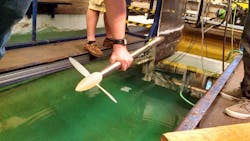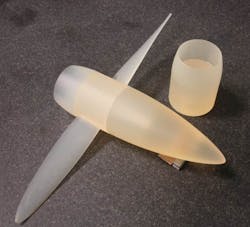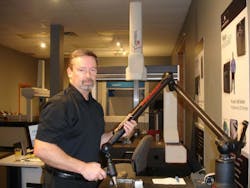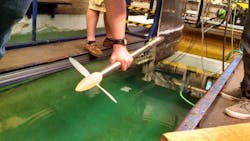3D Printing for Hire: The Case of the Persnickety Prop
Machine-tool distributor Burton Precision, Grand Rapids, Mich., specializes in metrology and 3D printing.
Recently, Burton Precision worked with University of Michigan’s Human Powered Submarine Team to ultimately make the propeller pictured below. What's interesting is that the partnership arose from a chance meeting at an open house for Grand Rapids Makers, an open-community laboratory with a machine shop, workshop, and design studio.
“We were demonstrating our products, and someone [attending] said his brother belonged to the Human Powered Submarine Team at U of M, and they were having problems with a point-cloud file for a propeller design,” says Rick Kerkstra, V.P. at Burton Precision.
They couldn’t convert the file to a ‘friendly’ file to get a cutter path on a CNC machine and make the part. So, Kerkstra connected with Jeremy Werner of U of M’s Naval Architecture and Marine Engineering Department, and President of the Human Powered Submarine Team.
Werner’s team was using a propeller-design program called Open Prop, and it wasn’t letting them export files in any useful formats. The point-cloud files didn’t include outward normal vectors, and units were in meters — arranged with 100 rows of points along the prop-blade lengths, and 40 points per row (for 20 on either blade side). The researchers wanted to make the toolpath in GibbsCAM, but it wasn’t as simple as a file conversion.
“It never is,” says Kerkstra.
“So Werner sent me an STL file that I read into Geomagic Studio Software in an attempt to create a nurbs surface.” Nurbs surfaces are the mathematical models used in computer graphics to make and represent curves and surfaces. Geomagic is software used on 3D Systems machines.
The low-resolution files had blade edges that garbled results, so Werner did four or five re-writes to get a usable file.
Once they had a good surface file, Kerkstra offered to 3D print the propeller ... and that opened another door. It was then that the teams had further discussions about material strength, and tested the preliminary design using a scale version with the overall functionality of the 3D-printed part.
In fact, the first surface files failed the initial testing in a simulator because the blades were too thin.
So Burton Precision revised the design, which then passed. After that, they 3D printed the propeller on a 3D Systems ProJet 3500 HDMax printer in a plastic material called Crystal. The final blade assembly is 10 in. long:
For most projects, it only takes Burton Precision one to two days to complete the data conversion, if they get clean printable files. But because 3D printing is so new, Kerkstra says they often need to educate engineers about what constitutes a 3D printable file. After that, it only takes a few hours to print the part.
“Burton Precision gave hands-on learning for [everyone] involved in the scale model propeller test,” says Werner. Full-scale, self-propelled tests in April confirm the new propeller works perfectly.
For future projects, U of M also bought a 3D-printing machine from Burton Precision.
About the Author
Elisabeth Eitel Blog
Elisabeth is Senior Editor of Machine Design magazine. She has a B.S. in Mechanical Engineering from Fenn College at Cleveland State University. Over the last decade, Elisabeth has worked as a technical writer — most recently as Chief Editor of Motion System Design magazine.




